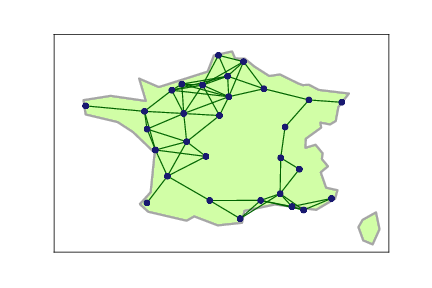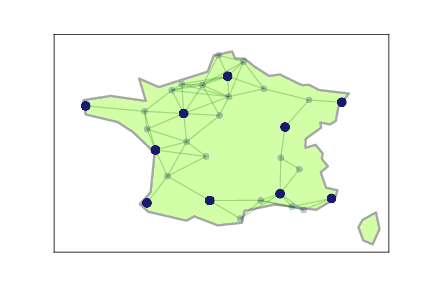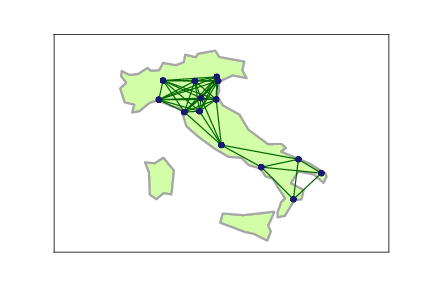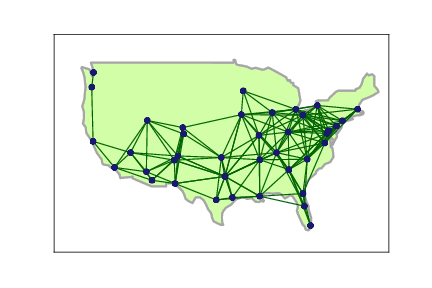Using Code 2 - NetworkX
Goals
- Read in data from files.
- Use pre written code to minimise advertising costs for Shed Josie.
For this session you will be using the library networkx. This may need to be installed using pip:
pip install networkxorpip install --user networkxon a university computer.
Josie’s Shed
Josie’s Shed is a chain of garden stores based in Grenoble. They are going to embark on a national radio advertising campaign to promote their stores across the whole of France, using local radio station. They have identified 30 cities which much hear the radio advertisments. Furthermore they do not need to advertise on every local radio station, as cities close enough to one another can here eachothers’ radio broadcasts:

The 30 cities form a network, and cities with an edge between them are close enough to listen to one another’s radio broadcasts.
Your task is to identify the minimum number of cities Josie’s Shed needs to broadcats from, and identify which cities to broadcast from, in order to reach all 30 cities in France.
Question 1
First let’s download and read in some data.
Download:
Save these in the same folder as the notebook you are working on.
Next, let’s read in the list of cities:
>>> with open('french_cities.txt', 'r') as f:
... cities = f.read()>>> cities
'Amiens\nAvignon\nBiarritz\nBordeaux\nBrest\nCaen\nCalais\nDijon\nGrenoble\nLa Rochelle\nLe Havre\nLe Mans\nLille\nLimoges\nLyon\nMarseilles\nMontpellier\nNancy\nNantes\nNice\nOrleans\nParis\nPerpignon\nPoitiers\nReims\nRennes\nRouen\nStranbourg\nToulon\nToulouse'This is a string of a list of cities, each separated by the line break character \n. Let’s break this into a list:
>>> cities_list = cities.split('\n')
>>> cities_list
['Amiens',
'Avignon',
'Biarritz',
'Bordeaux',
'Brest',
'Caen',
'Calais',
'Dijon',
'Grenoble',
'La Rochelle',
'Le Havre',
'Le Mans',
'Lille',
'Limoges',
'Lyon',
'Marseilles',
'Montpellier',
'Nancy',
'Nantes',
'Nice',
'Orleans',
'Paris',
'Perpignon',
'Poitiers',
'Reims',
'Rennes',
'Rouen',
'Stranbourg',
'Toulon',
'Toulouse']Now let’s read in the adjacency matrix (a matrix where rows and columns represent cities, and entries are either a 1 or a 0 depending if those cities have an edge between them in the network). As this is a matrix of numbers, we’ll use the numpy library to make things easier:
>>> import numpy as np>>> adjacency_matrix = np.genfromtxt('french_distances.csv', delimiter=',')Looking at adjacency_matrix we see it’s a list of lists, each list containing 30 numbers, 0s or 1s.
Looking at the map, there is a link between Marseilles and Nice. Marseilles is city number 15, and Nice is number 19:
>>> cities_list.index('Marseilles')
15>>> cities_list.index('Nice')
19So we’d expect a link between these in the adjacency matrix:
>>> adjacency_matrix[15, 19]
1.0On the other hand, Amiens and Avignon (cities 0 and 1) are too far away to share radio waves, so they should not have a link:
>>> adjacency_matrix[0, 1]
0.0Now identifying which cities to broadcast from is a common problem when framed as a network. We are tyring to find the minimum dominating set. We can use networkx to find this:
>>> import networkx as nx
>>> G = nx.from_numpy_array(adjacency_matrix)
>>> dominating_set = nx.dominating_set(G)
>>> dominating_set
{0, 1, 2, 4, 7, 9, 11, 19, 27, 29}So Josie’s Shed only needs to broadcast in 10 cities to reach every one of the 30 targeted cities.
What are those cities?
>>> for city_number in dominating_set:
... print(cities_list[city_number])
Amiens
Avignon
Biarritz
Brest
Dijon
La Rochelle
Le Mans
Nice
Stranbourg
ToulouseThat is:

Question 2
Shed Josie want to begin an advertsing campaign in Italy. Repeat this analysis for Italy:

Question 3
Shed Josie want to begin an advertsing campaign in the USA. Repeat this analysis for the USA:
